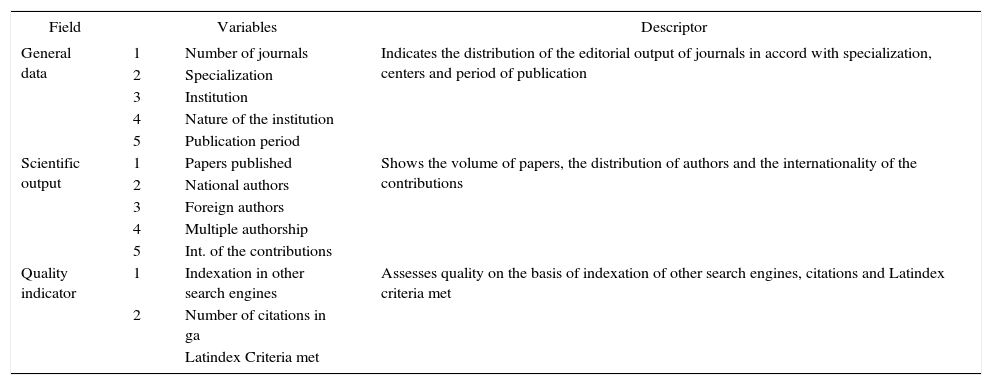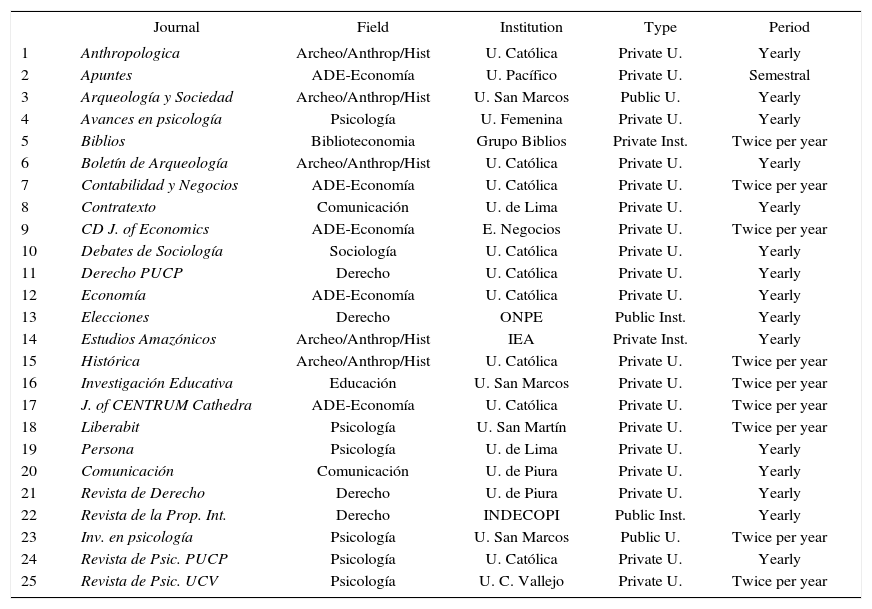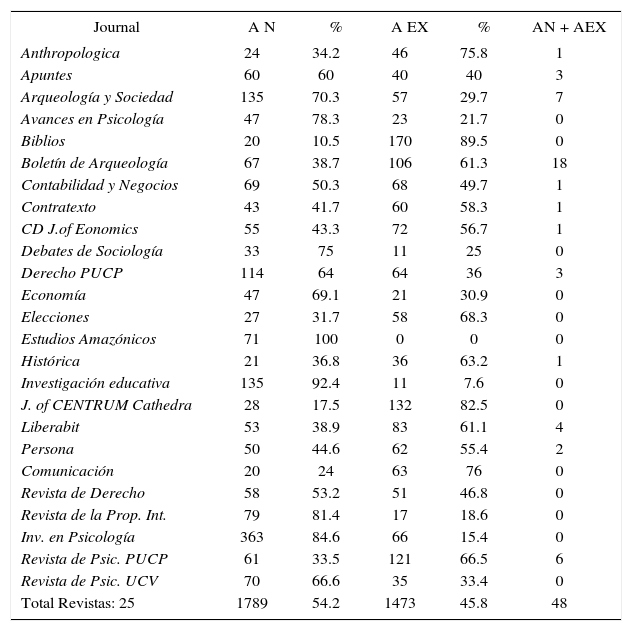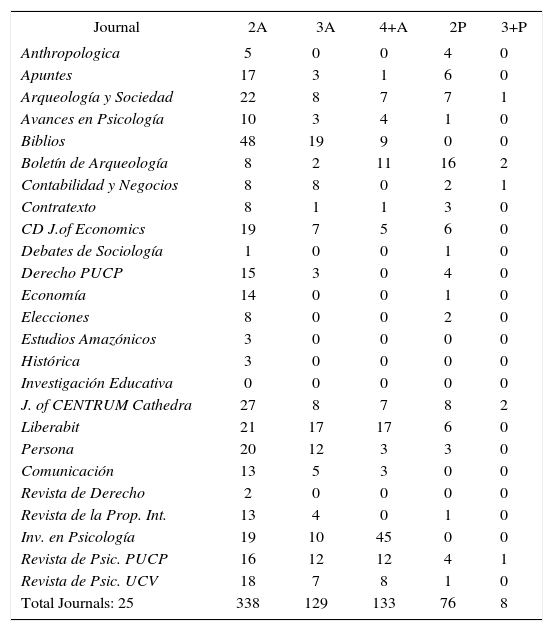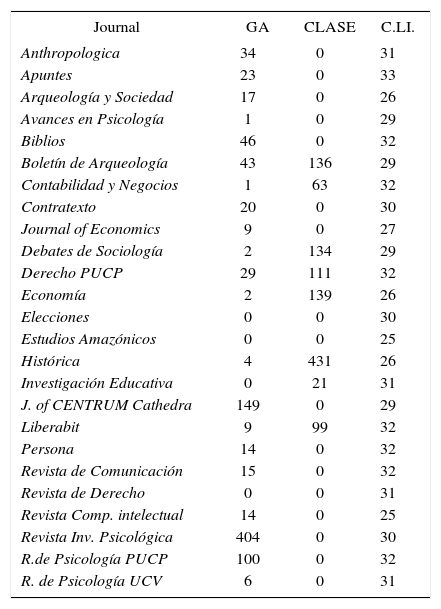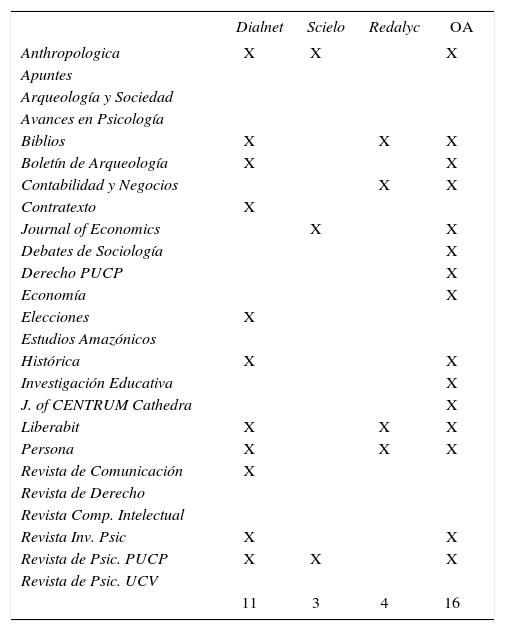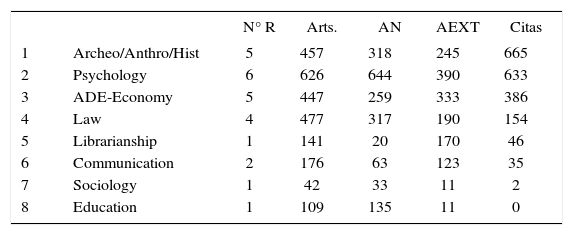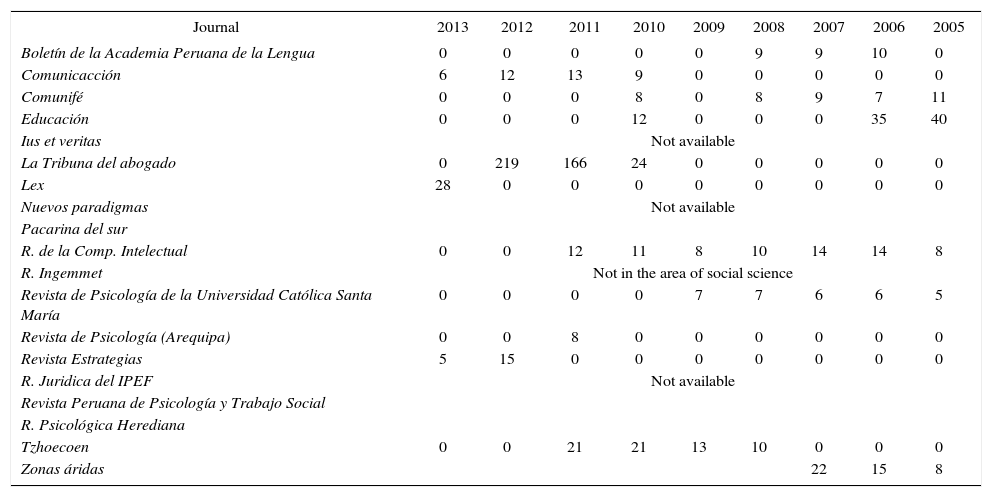This paper analyzes the scientific production and leading indicators of international visibility of 25 Peruvian social science journals indexed in Latindex between 2005 and 2013, finding, with respect to other areas of knowledge, that there are more journals in the field of Psychology, Economy and Law and a large, relatively balanced quantity of articles published by both national and foreign authors. Moreover, papers by authors associated with private universities appear more often in the pages of these journals than those from public universities. Some incentive measures are proposed to improve the quality, number of citations and presence in international search engines.
En el presente artículo se analiza la producción científica y los principales indicadores de visibilidad internacional de 25 revistas peruanas del campo de las Ciencias Sociales indexadas en el Catálogo Latindex entre los años 2005-2013. Los resultados indican que hay un mayor número de revistas del campo de la Psicología, Economía y Derecho respecto del resto de áreas de conocimiento. Se observa un volumen importante de artículos publicados así como un equilibrio entre artículos a cargo de autores nacionales y extranjeros. Se constata un claro dominio de las universidades privadas frente a las públicas en la tarea editorial de revistas científicas. Se proponen acciones e iniciativas de incentivo para mejorar la calidad, número de citas y la presencia en motores de búsqueda internacional.
International figures reflect significant economic growth in some South American countries in recent years. With an average yearly growth rate above 5% over the last five years, Peru stands at the forefront of this growth. In the field of education, this growth has driven the creation of a significant number of private universities and several public universities. Analysis of the scientific production of Peruvian scientific journals can serve as an objective measure of the consistency of this remarkable economic expansion. This examination will also help us to understand if the expansion of the university market is backed by genuine intellectual work produced by networks of researchers publishing material of quality that enjoys national and international visibility. This examination can also help detect strengths and weaknesses of current policies, while delineating future actions to correct and improve them. It is especially important to examine these data in the field of Social Sciences, because this area of knowledge is the focus of the greatest number of majors and faculties in the country. These schools include Law, Communications, Economy and Psychology, whose expansion is accompanied by considerable growth of journals indexed in Latindex.
Testing shows that there is no bibliographic research addressing the development or any degree of compliance with quality standards. We believe that an initial exploration of these features can help one attain a general understanding of how scientific output is organized in this field of knowledge and of some of the current objective quality standards.
THEORETICAL FRAMEWORKBibliometric study of field of medical science in PeruSince the end of the decade of the 1990s, a line of bibliometric research was launched that focused on the parameters of quality and visibility of scientific journals published in Peru. Concretely, these studies have examined the field of medicine and bio-sciences. Huamaní and Pacheco, for example, examine the collaborative scientific output in the medical field (Huamaní and Pacheco-Romero, 2011; Huamaní and Mayta-Tristán, 2010). Other studies analyze the deficiencies and adjustment of editorial policies that serve to improve the international position of the journals (Burstein and Cabezas, 2010; Huamaní and Pacheco-Romero, 2009; Arroyo-Hernández, Zukerán-Medina and Miranda-Soberón, 2009). Romaní and Wong (2009) examine the filtering protocols for searching papers in the Scielo catalogue, and the main indicators of visibility. Cáceres and Mendoza (2009) propose a global analysis of scientific output in the field of medicine. The main conclusions reveal a low level of production and indexation for this class of journals, though it is the highest when compared to journals of other fields (Huamaní and Pacheco-Romero, 2011; Romaní and Wong, 2009; Gerstein, 2005). The likely cause of this low level of output were found in the rigorous, prolonged peer review processes (Cuevas and Mestaza, 2002) that determines whether a paper is to be published or not (Burstein y Cabezas, 2010). A positive datum was revealed in the high degree of online visibility of these journals using internet search engines (Huamaní and Pacheco-Romero, 2009).
Another exploratory line, considerably less prolific than the one cited above, looks at student contributions to medical journals (Taype-Rondán et al., 2011; Alarcón-Villaverde, Romaní and Gutiérrez, 2010; Mayta-Tristán, Pena-Oscuvilca, 2009; Molina-Ordóñez, Huamaní y Mayta-Tristán, 2008; Huamaní, Chávez-Solís y Mayta-Tristán, 2008; Gutiérrez y Mayta-Tristán, 2003). The results indicate that Peruvian educational and research centers have made considerable efforts to publish research and belong to recognized indexation systems. These efforts comprise a value added in terms of quality to the institutions, while improving their global visibility and establishing new linking mechanisms with research groups that in the future lead to the production of new papers.
The field of Social Sciences in Spain as a Latin American paradigmIn the past decade, Spain has undergone a process of modification of hiring criteria of both tenured and associate professors. The system of examination that candidates must pass in order to secure accreditation has been complemented with a series of international merit objectives for evaluating research activity. This has driven the development of international benchmark models, which apply criteria similar to those used in large classification systems, such as isi-jcr (Thomson Reuters) and Scopus. In the field of Social Sciences there are diverse tools for measuring the quality of journals, such as the impact factor, on the basis of systematic indexation of citations and other representative criteria. in-recs1 ccalculates the impact of 761 Social Science journals in ten categories. The open access consultation figure to date comes to 878,507 visits. dice (Difusión y Calidad Editorial de las Revistas Españolas de Humanidades y Ciencias Sociales y Jurídicas) [Dissemination and Editorial Quality of Spanish Humanities, Social Science and Law Journals] was established as a collaborative convention between the Consejo Superior de Investigaciones Científicas (csic) and la Agencia Nacional de Evaluación de la Calidad y Acreditación (aneca). dice provides the indicators international dissemination value and degree of internationality, which are based on quantifying and evaluating citations and the other data relevant to researchers and publishers. The search can be performed by journal by the field subset. Miar2 is a system for quantitatively gauging visibility of the periodical journals in Social Sciences as a function of their presence in diverse data bases.
There are several complementary tools that do not specifically supply an impact index or a measure of visibility of journals. They do, however, offer other relevant indicators of the quality of publications. The Resh3 platform systemizes the criteria met by the journals in accord with the quality parameters set by three evaluation institutes: cneai, aneca and Latindex. This platform attempts to supply indicators of editorial quality, a system for evaluating manuscripts, institutional aperture for submissions, internationality and other criteria. Other instruments are also used in Social Sciences when there is no specific quantitative information available. In this group we have systems based on the opinion of experts, who determine quality on a three-fold scale, such as the Catalonian system Cahrus+.4
Nonetheless, from the Latin American standpoint, it is very difficult to develop an efficient system that brings together these indicators in a way enjoying wide support, without mentioning the difficulties of bringing together the array of journals and making this information assessable from diverse data bases and points of entry. In light of this impossibility, in general terms, the search of journals and papers is performed through three large engines: Redalyc (Mexico), Scielo and Dialnet.
The Scielo-Perú engine is coordinated in Peru by the Consejo Nacional de Ciencia, Tecnología e Innovación Tecnológica (concytec), la Universidad Nacional Mayor de San Marcos and la Representación en Perú de la Organización Panamericana de la Salud. Specifically, in the field of Humanities there are five Social Science journals that total 38 numbers, as follows:
- 1.
Anthropologica, 9 numbers
- 2.
Areté. Revista de Filosofía, 13 numbers
- 3.
Journal of Economics, Finance and Administrative Science, 8 numbers
- 4.
Liberabit. Revista de Psicología, 13 numbers
- 5.
Revista de Psicología (pucp), 6 numbers
Several studies have been performed to complement the operation of these procedures and facilitate gathering of results in Social Science journals, thereby securing other comparative indicators that current systems cannot provide to researchers. Lopez Baena, Cases and Barbancho Valcárcel Medina (2005) conducted an evaluation protocol of journals to complement the ISI database. In another line of research, the bibliometric protocols of the Resh catalogue (Alcaín, Roman Toledo Roman and Giménez, 2008) and Latindex (Alcaín and Lascurain, 2002) are presented. Both studies support the quality of the editorial process, peer review, international visibility and impact indexes, among other indicators. Borrego and Urbano (2006) examine the difficulties of applying bibliometric impact measures based on citation figures drawn from the Thomson Scientific data bases (formerly isi). Vázquez, Urdín Caminos and Román Román (2003) examine of performance of Spanish journals in the field of health sciences against the Latindex quality criteria and their degree of online accessibility. In the field of Communications, the work of Fernández Quijada (2010, 2009) analyze the similarities and differences between journals. Román Román, Vázquez Valero and Urdín Camino (2002) analyze the Latindex editorial quality criteria within the framework of the evaluation of Spanish journals in the fields of Humanities and Social Sciences. Alcaín and Lascurain (2002) analyzed 221 Latin American psychology journals. Gamboa (1998) effectuates a prototype of the Latindex Latin American index of scientific journals. However, in the field of Social Sciences there are no studies that describe the production of authors and institutions, while allowing comparisons and evaluation of the impact in accord to objective, validated indicators.
OBJECTIVESThis paper proposes the three following objectives:
- 1.
To perform a quantitative and qualitative study on the basis of standardized measures of impact of the scientific production of Peruvian Social Science journals listed in the Latindex catalogue from 2005 to 2013.
- 2.
On the basis of results of analysis of data, to discern a rating scale of the journals and institutions that publish them as a function of their position in the eyes of the international scientific community.
- 3.
To propose measures aimed at improving the quality and degree of international impact of journals.
The analysis applied in this study is performed on the basis of a bibliometric count of the papers published in scientific journals from 2005 to 2013. This period was selected because it frames an extensive interval that is sufficient to discern the development of journals and obtain, finally, a longitudinal perspective of the most recent research in this field, which is concurrent with the recent expansion of university market in Peru.
The review of the literature was performed in four phases:
- 1.
Localization of the total universe of Social Science journals indexed in the Latindex catalogue. To achieve this, the advanced search was performed as follows: Latindex/Tema: Ciencias Sociales/Indizada-Resumida at: Latindex Catálogo/País: Perú.
- 2.
Inventory of the totality of papers published in each journal from 2005 to 2013. This data was gathered from the official web page of each journal and using a specialized search engine such as Scielo, Amauta or Redalyc.
- 3.
Construction of a data base containing thirteen relevant variables of the scientific papers published in journals.
- 4.
Comparative analysis of the indicators for the period under study, organizing these into three fields and six categories.
The analytical variables are selected in order to obtain information of the journals across three fields:(Table 1):
- 1.
General data. These indicate number of journals, specialization, publisher and the publication period.
- 2.
Scientific output. This field seeks to quantify the scientific output and learn how authorship of papers is organized.
- 3.
Quality indicators. This includes the visibility of journals in other search engines, the number of citations in Google Academic (ga), and the Class and number of Latindex criteria met.
Indicadores de análisis.
| Field | Variables | Descriptor | |
|---|---|---|---|
| General data | 1 | Number of journals | Indicates the distribution of the editorial output of journals in accord with specialization, centers and period of publication |
| 2 | Specialization | ||
| 3 | Institution | ||
| 4 | Nature of the institution | ||
| 5 | Publication period | ||
| Scientific output | 1 | Papers published | Shows the volume of papers, the distribution of authors and the internationality of the contributions |
| 2 | National authors | ||
| 3 | Foreign authors | ||
| 4 | Multiple authorship | ||
| 5 | Int. of the contributions | ||
| Quality indicator | 1 | Indexation in other search engines | Assesses quality on the basis of indexation of other search engines, citations and Latindex criteria met |
| 2 | Number of citations in ga | ||
| Latindex Criteria met | |||
Without initial discrimination, the result of the search shows a total of 45 journals, which were analyzed individually. These data are entered into an xls format special file in order to build a basic statistical results tables. From an initial review, we find that the engineering journal Ingemmet, appears somewhat incongruously on this list. Since this journal does not fall within the scope of this study, it was excluded. We observe that 10 journals were not available online. As such, we could not include this information in the analysis. Once the data on each journal was gathered, it was found that several of these began to be published sometime after 2005, while others ceased to be published before 2013. Still others several exhibits gaps in periodicity (Appendix 1). If we include such journals, it could create an incorrect picture of the output when compared to publications that have been published with regular periodicity. As such, we decided to set an inclusion criterion. We limited the sample to those journal publishing up to three times per year, because this level of presence is acceptable for the period of eight years under study. This is a reasonable approach in order not to affect the comparative reading of the subset and because this periodicity can contemplate situations that involve an involuntary interruption or simple lag time in the release of numbers online. After filtering, we proceeded to perform the comparative analysis of 25 journals which yielded the results shown in Table 2.
Datos generales.
| Journal | Field | Institution | Type | Period | |
|---|---|---|---|---|---|
| 1 | Anthropologica | Archeo/Anthrop/Hist | U. Católica | Private U. | Yearly |
| 2 | Apuntes | ADE-Economía | U. Pacífico | Private U. | Semestral |
| 3 | Arqueología y Sociedad | Archeo/Anthrop/Hist | U. San Marcos | Public U. | Yearly |
| 4 | Avances en psicología | Psicología | U. Femenina | Private U. | Yearly |
| 5 | Biblios | Biblioteconomia | Grupo Biblios | Private Inst. | Twice per year |
| 6 | Boletín de Arqueología | Archeo/Anthrop/Hist | U. Católica | Private U. | Yearly |
| 7 | Contabilidad y Negocios | ADE-Economía | U. Católica | Private U. | Twice per year |
| 8 | Contratexto | Comunicación | U. de Lima | Private U. | Yearly |
| 9 | CD J. of Economics | ADE-Economía | E. Negocios | Private U. | Twice per year |
| 10 | Debates de Sociología | Sociología | U. Católica | Private U. | Yearly |
| 11 | Derecho PUCP | Derecho | U. Católica | Private U. | Yearly |
| 12 | Economía | ADE-Economía | U. Católica | Private U. | Yearly |
| 13 | Elecciones | Derecho | ONPE | Public Inst. | Yearly |
| 14 | Estudios Amazónicos | Archeo/Anthrop/Hist | IEA | Private Inst. | Yearly |
| 15 | Histórica | Archeo/Anthrop/Hist | U. Católica | Private U. | Twice per year |
| 16 | Investigación Educativa | Educación | U. San Marcos | Private U. | Twice per year |
| 17 | J. of CENTRUM Cathedra | ADE-Economía | U. Católica | Private U. | Twice per year |
| 18 | Liberabit | Psicología | U. San Martín | Private U. | Twice per year |
| 19 | Persona | Psicología | U. de Lima | Private U. | Yearly |
| 20 | Comunicación | Comunicación | U. de Piura | Private U. | Yearly |
| 21 | Revista de Derecho | Derecho | U. de Piura | Private U. | Yearly |
| 22 | Revista de la Prop. Int. | Derecho | INDECOPI | Public Inst. | Yearly |
| 23 | Inv. en psicología | Psicología | U. San Marcos | Public U. | Twice per year |
| 24 | Revista de Psic. PUCP | Psicología | U. Católica | Private U. | Yearly |
| 25 | Revista de Psic. UCV | Psicología | U. C. Vallejo | Private U. | Twice per year |
25
SpecializationsChart 1 shows the field of Psychology leads all other with a total of six indexed journals, followed by ade/Economy; and Archeology, Anthropology and History with five each. Next is Law with four, followed by Communications with two and several fields with only one journal each, i.e., Librarianship, Education and Sociology.
InstitutionHere we can see the editorial production by institutions (Figure 2). We note that the center with the highest number of indexed journals is the Pontificia Universidad Catolica del Peru with 9 journals, followed by the National University of San Marcos with 3 publications, and the Lima University and the University of Piura with 2 each. The latter two universities are alsoprivate. The other centers publishing only one jurnal each are as follows: Biblios, Esan, Instituto de Estudios Amazónicos, Instituto Nacional de Defensa de la Competencia y de la Protección de la Propiedad Intelectual, Onpe, Universidad César Vallejo, Universidad Femenina, Universidad del Pacífico and Universidad San Martín de Porres.
Of the total sample of journals (Figure 3), 18 are published by private universities, three by the public university Mayor de San Marcos; two by private publishers (Biblios and the Institute of Amazonian Studies), which publish journals of the same name. Finally, the National Office of Electoral Processes (onpe) publishes by the magazine Elecciones; and the National Institute for the Defense of Competition and Protection of Intellectual Property publishes the Revista de la Competencia y la Propiedad Intelectual (Journal of Competition and Intellectual Property).
PeriodicityFourteen journals are published on a yearly basis, while eleven come out twice per year.
Table 2 shows the breakdown of this first section of the analysis.
Field 2. Scientific outputA total of 2,475 papers published from 2005 to 2013 were counted.
Papers publishedAs shown in Chart 4, Derecho (Law), printed by the Pontifical Catholic University of Peru, has published the most papers, with a total of 206 contributions. Investigación Psicológica (Psychological Research) was next with 179 and Biblios third with 141. Liberabit, also a psychology journal, of the University San Martin de Porres, was next with 135 papers. Arqueología y Sociedad (Archaeology and Society) of the University of San Marcos also tallies 135 papers. Other journals topping 100 articles in the period were: Boletín de Arqueología with 119, and Cuadernos de Difusión, which in 2009 changed its name to Journal of Economics and is published by Esan, came in at 118. Revista de Derecho, of Universidad de Piura tallied 110, and Investigación Educativa of Universidad Nacional Mayor de San Marcos tallied 109. In a tightly packed group we find 11 journals with output ranging from 70 to 90 papers over the eight-year period under study. This group is followed by Debates de Sociología with 42 papers and Histórica with 57, both of which are published by Universidad Católica. Chart 5 shows the development of all journals under study over the eight-year window of the study.
National authorsOf a total of 3,262 authors, 1,789 (54.2%) are Peruvian nationals and 1,473 (45.8%) are foreigners. The journal publishing the most national authors is Investigación en Psicología with 363 papers, at a rate of 45.3 per year. The following journals published more than 100: Arqueología y Sociedad e Investigación Educativa, both with 135; and Derecho with 114. Those publishing the fewest Peruvian authors are Antrophologica with 24, followed by Histórica with 21 and Comunicación and Biblios, with 20 each. The variance of this indicator between two journals in the same filed is noteworthy. While, Boletín de Arqueología published 38.7% Peruvian authors, Arqueología y Sociedad published 70.3%. In the case of Derecho, we observe a similar pattern, with 64% Peruvian national authors published. For Debates de Sociología this rate reaches 75%, but with only 33 papers. The higher rates of papers published by Peruvian authors could obey both the customary practice of the journal and the fact that the field these journals address do not particularly attract foreign researchers. This pattern is most evident in journals such as Investigación Educativa and Derecho, which focus largely on matters of Peruvian law. We should also mention that both of these journals publish a high number of papers authored by faculty. In contrast to this tendency, the journals ade-Economía, Journal of Economics and Journal ofcentrumCathedra publish far fewer papers by Peruvian authors, as shown in Table 3.
Producción por autores.
| Journal | A N | % | A EX | % | AN + AEX |
|---|---|---|---|---|---|
| Anthropologica | 24 | 34.2 | 46 | 75.8 | 1 |
| Apuntes | 60 | 60 | 40 | 40 | 3 |
| Arqueología y Sociedad | 135 | 70.3 | 57 | 29.7 | 7 |
| Avances en Psicología | 47 | 78.3 | 23 | 21.7 | 0 |
| Biblios | 20 | 10.5 | 170 | 89.5 | 0 |
| Boletín de Arqueología | 67 | 38.7 | 106 | 61.3 | 18 |
| Contabilidad y Negocios | 69 | 50.3 | 68 | 49.7 | 1 |
| Contratexto | 43 | 41.7 | 60 | 58.3 | 1 |
| CD J.of Eonomics | 55 | 43.3 | 72 | 56.7 | 1 |
| Debates de Sociología | 33 | 75 | 11 | 25 | 0 |
| Derecho PUCP | 114 | 64 | 64 | 36 | 3 |
| Economía | 47 | 69.1 | 21 | 30.9 | 0 |
| Elecciones | 27 | 31.7 | 58 | 68.3 | 0 |
| Estudios Amazónicos | 71 | 100 | 0 | 0 | 0 |
| Histórica | 21 | 36.8 | 36 | 63.2 | 1 |
| Investigación educativa | 135 | 92.4 | 11 | 7.6 | 0 |
| J. of CENTRUM Cathedra | 28 | 17.5 | 132 | 82.5 | 0 |
| Liberabit | 53 | 38.9 | 83 | 61.1 | 4 |
| Persona | 50 | 44.6 | 62 | 55.4 | 2 |
| Comunicación | 20 | 24 | 63 | 76 | 0 |
| Revista de Derecho | 58 | 53.2 | 51 | 46.8 | 0 |
| Revista de la Prop. Int. | 79 | 81.4 | 17 | 18.6 | 0 |
| Inv. en Psicología | 363 | 84.6 | 66 | 15.4 | 0 |
| Revista de Psic. PUCP | 61 | 33.5 | 121 | 66.5 | 6 |
| Revista de Psic. UCV | 70 | 66.6 | 35 | 33.4 | 0 |
| Total Revistas: 25 | 1789 | 54.2 | 1473 | 45.8 | 48 |
We counted 1,473 foreign authors. Biblios published the highest number of foreign authors with 170 (89.5%), followed by Jouranal of centrumCathedra with 132 (82.5%). A second grouping came in as follows: Revista de Psicología of Pontificia Universidad Católica del Perú with 121 (66.5%), Boletín de Arqueología with 106 (61.3%) and Liberabit with 83 (61.1%) of the total. Avances en Psicología, of Universidad Femenina, published only 23 foreign authored papers, or 21.7% of the total authors published over the eight-year period. Revista de Psicología of Universidad César Vallejo scored slightly higher in this area, with 35 papers published by foreign authors, or 33.4%. While this is a small number, it reflects an effort to internationalize in this recently founded university. Journals publishing the fewest foreign authors are Debates de Sociología and Investigación Educativa, with 11 papers each. Estudios Amazónicos is the only journal that did not publish a foreign author. The journal that has struck the best balance is Contabilidad y Negocios with 69 Peruvian national authors and 68 foreigners. Eleven of the 25 journals published more foreign authors than national researchers. These figures appear in Tabla 3.
Internationality of submissionsAnother relevant indicator of the quality of a journal is the volume of papers that are co-written by local and foreign authors. The Boletín de Arqueología published the most co-authorships of this kind, with 18 papers authored by a mix of Peruvian and foreign authors. In this regard, Arqueología y Sociedad has published 7 papers, Revista de Psicología of pucp follows with 6 and Liberabit with only 4. Anthropologica, Contabilidad y Negocios, Contratexto, Journal of Economics and Histórica each tallied only one. Thirteen journals of the sample have not published any co-authored papers of this kind. These figures are shown in Table 3.
Multiple authorsThis section presents authorship involving two or more authors and co-authored works by Peruvian national and foreign authors. The volume of papers by two authors comes to 338, with Biblios leading the way with 48 co-authorships, followed by Journal ofcentrumCathedra with 27 co-authorships, Arqueología y Sociedad with 22, Liberabit with 21 and Persona with 20. As for papers written by three authors, Biblios leads the way with 19, followed by Liberabit with 17, Revista de Psicología of pucp and Persona with 12, and Investigación en Psicología with 10. Finally, Investigación en Psicología is the most flexible in terms of co-authorships involving four or more authors with 45 papers. This journal has, in fact, published one article with twelve Peruvian authors and two papers with eleven authors. Liberabit has published 17, two of which were authored by six authors. Boletín de Arqueología published eleven multiple-authorships, one signed by ten authors and two signed by nine authors. Eleven journals did not publish any papers with more than four or more authors.
With regard to co-authored research involving authors from two countries, Boletín de Arqueología published 16 papers as follows: Peru/United States, Peru/Japan, Peru/United Kingdom, Peru/Germany. Journal ofcentrumCathedra has eight as follows: Peru/Spain, Peru/ United States, India/Malaysia, United States /New Zeeland. Liberabit published six papers by Latin American co-authors as follows: Argentina/Peru, Colombia/Chile. Finally, Revista de Psicología of PUCP published four.
As for papers with authors from three or more countries, we have Boletín de Arqueología with two and Journal ofcentrumCathedra also with two. Finally, Arqueología y Sociedad and Contabilidad y Negocios came in with one each. Twenty journals from the sample, did not publish any papers by authors from three or more countries.
En la Tabla 4 se resumen los datos de autorías múltiples.
Scientific output by multiple authors.
| Journal | 2A | 3A | 4+A | 2P | 3+P |
|---|---|---|---|---|---|
| Anthropologica | 5 | 0 | 0 | 4 | 0 |
| Apuntes | 17 | 3 | 1 | 6 | 0 |
| Arqueología y Sociedad | 22 | 8 | 7 | 7 | 1 |
| Avances en Psicología | 10 | 3 | 4 | 1 | 0 |
| Biblios | 48 | 19 | 9 | 0 | 0 |
| Boletín de Arqueología | 8 | 2 | 11 | 16 | 2 |
| Contabilidad y Negocios | 8 | 8 | 0 | 2 | 1 |
| Contratexto | 8 | 1 | 1 | 3 | 0 |
| CD J.of Economics | 19 | 7 | 5 | 6 | 0 |
| Debates de Sociología | 1 | 0 | 0 | 1 | 0 |
| Derecho PUCP | 15 | 3 | 0 | 4 | 0 |
| Economía | 14 | 0 | 0 | 1 | 0 |
| Elecciones | 8 | 0 | 0 | 2 | 0 |
| Estudios Amazónicos | 3 | 0 | 0 | 0 | 0 |
| Histórica | 3 | 0 | 0 | 0 | 0 |
| Investigación Educativa | 0 | 0 | 0 | 0 | 0 |
| J. of CENTRUM Cathedra | 27 | 8 | 7 | 8 | 2 |
| Liberabit | 21 | 17 | 17 | 6 | 0 |
| Persona | 20 | 12 | 3 | 3 | 0 |
| Comunicación | 13 | 5 | 3 | 0 | 0 |
| Revista de Derecho | 2 | 0 | 0 | 0 | 0 |
| Revista de la Prop. Int. | 13 | 4 | 0 | 1 | 0 |
| Inv. en Psicología | 19 | 10 | 45 | 0 | 0 |
| Revista de Psic. PUCP | 16 | 12 | 12 | 4 | 1 |
| Revista de Psic. UCV | 18 | 7 | 8 | 1 | 0 |
| Total Journals: 25 | 338 | 129 | 133 | 76 | 8 |
In this section, we analyze the citations of papers published within the analysis window. We employed two citation visibility indicators: Google Academic and citations in the Class search engine: Latin American Citations in Social Science and Humanities. Table 5 shows these figures.
Citations and Latindex criteria.
| Journal | GA | CLASE | C.LI. |
|---|---|---|---|
| Anthropologica | 34 | 0 | 31 |
| Apuntes | 23 | 0 | 33 |
| Arqueología y Sociedad | 17 | 0 | 26 |
| Avances en Psicología | 1 | 0 | 29 |
| Biblios | 46 | 0 | 32 |
| Boletín de Arqueología | 43 | 136 | 29 |
| Contabilidad y Negocios | 1 | 63 | 32 |
| Contratexto | 20 | 0 | 30 |
| Journal of Economics | 9 | 0 | 27 |
| Debates de Sociología | 2 | 134 | 29 |
| Derecho PUCP | 29 | 111 | 32 |
| Economía | 2 | 139 | 26 |
| Elecciones | 0 | 0 | 30 |
| Estudios Amazónicos | 0 | 0 | 25 |
| Histórica | 4 | 431 | 26 |
| Investigación Educativa | 0 | 21 | 31 |
| J. of CENTRUM Cathedra | 149 | 0 | 29 |
| Liberabit | 9 | 99 | 32 |
| Persona | 14 | 0 | 32 |
| Revista de Comunicación | 15 | 0 | 32 |
| Revista de Derecho | 0 | 0 | 31 |
| Revista Comp. intelectual | 14 | 0 | 25 |
| Revista Inv. Psicológica | 404 | 0 | 30 |
| R.de Psicología PUCP | 100 | 0 | 32 |
| R. de Psicología UCV | 6 | 0 | 31 |
The journal with the largest number of citations in Google Academic is Revista Investigación Psicológica of the Universidad de San Marcos, with 404 citations. In fact, this journal has more citations of different papers. Among these, we find a paper by Martínez, M. (2006) “La investigación cualitativa: síntesis conceptual”, 9 (1), 123-146, with 154; Riveros, Q., V. Hernández and B. Rivera (2007): “Niveles de depresión y ansiedad en estudiantes universitarios de Lima metropolitana”, 10 (1), 91-102, with 39. We find that Journal ofcentrumCathedra is also cited frequently in this search engine, with 149 citations. The most frequently cited article is Zhu, J. 2011. “Airlines performance via two-stage network DEA approach”, 4 (2), 260-269, with 13 citations, followed by Sumner, S., R. Johnsony L. Soenen (2010): “Spillover effects among gold, stocks, and bonds”, 3 (2), 106-120, with 12. In third place we find Revista de Psicología of pucp with 100 citations, whose most frequently cited paper is Zubieta, E., M. Beramendi, F. Sosa y J. A. Torres. 2011. “Sexismo ambivalente, estereotipos y valores en el ámbito militar”, 29 (1), 101-130, with 5 citations. Biblios also stand out with two papers with 23 citations each.
Different citation figures come back from papers stored in Clase. These data do not correlate with the Google Academic data. The most frequently cited journal is Histórica, with 431 citations, followed by Economía with 139, Boletín de Arqueología with 136 and Debates de Sociología with 134, which in Google Academic only has two citation entries. Only Apuntes meets Latindex criteria with a total of 33, while Biblios, Contabilidad y Negocios, Derecho (pucp), Liberabit, Persona, Revista de Comunicación and Revista de Psicología (pucp) stand at 32 each. Those journals with the lowest scores are Estudios Amazónicos and Revista de la Competencia Intelectual, which meet only 25 criteria each. Histórica, which fulfills 26 criteria, Exhibits 431 citations in Clase, while Economía also fulfills 26 Latindex criteria and notches 139 entries in Clase.
Indexation in other search engines and the Open AccessFinally, we examine the visibility of these journals in other search engines (Table 6). Eleven journals are visible in Dialnet, three in Scielo and four in Redalyc. Fifteen journals employ the Open Access (oa) publishing system. All of the journals from Pontificia Universidad Católica del Perú are gathered in the pucp journal portal, while those of the Universidad de San Marcos are accessible through the Libraries Digital System.
Indexation in other search engines.
| Dialnet | Scielo | Redalyc | OA | |
|---|---|---|---|---|
| Anthropologica | X | X | X | |
| Apuntes | ||||
| Arqueología y Sociedad | ||||
| Avances en Psicología | ||||
| Biblios | X | X | X | |
| Boletín de Arqueología | X | X | ||
| Contabilidad y Negocios | X | X | ||
| Contratexto | X | |||
| Journal of Economics | X | X | ||
| Debates de Sociología | X | |||
| Derecho PUCP | X | |||
| Economía | X | |||
| Elecciones | X | |||
| Estudios Amazónicos | ||||
| Histórica | X | X | ||
| Investigación Educativa | X | |||
| J. of CENTRUM Cathedra | X | |||
| Liberabit | X | X | X | |
| Persona | X | X | X | |
| Revista de Comunicación | X | |||
| Revista de Derecho | ||||
| Revista Comp. Intelectual | ||||
| Revista Inv. Psic | X | X | ||
| Revista de Psic. PUCP | X | X | X | |
| Revista de Psic. UCV | ||||
| 11 | 3 | 4 | 16 |
With regard to the work methodology, we believe the data collection system we have used for this research has worked properly for the purpose of securing data on the diverse variables analyzed herein. This has been a long and hard task because localization of the data corresponding to variables of each of the indexed journals has had to be entered manually on an individual basis into the data base. Since there really is no tool for filtering the searches that is capable of automatically displaying results, some data entry errors may have occurred that could affect tallies. Nonetheless, this procedure was the only possible way to map of scientific output, insofar as there are no instruments available for doing this.
It would be interesting if Latindex incorporated more exact information in its system for users. Useful information might include: which evaluation criteria were fulfilled by the journal; more exact filter systems in the Catalogue option; and additional tools for searching citations and versions of the same paper or to perform specific searches by journal, institution and author. Finally, the integration of the platform with other similar search engines, such as Clase or Scielo would be a great aid in continuing along this line.
The analysis of the figures points to different interpretations in accord to how we approach the data. In general terms we have been able to corroborate the existence of a significant number of papers (2,475), equal to an average of 100 papers per journal during the eight-year study window. We cannot say, however, that output and volume of citations are homogenous across all journals, despite somewhat insular institutional efforts to cover and project their interests among their target public or simply to report the research activities of faculty. This situation is exemplified in the work of Universidad Católica, whose nine journals are published regularly. All of these journals maintain a corporate style in the design of both web portals and print versions. The differences between these journals, however, become clear when we examine the volume and variety of papers they publish. Even though it lies somewhat beyond the parameters of this paper, we could say that the same phenomenon occurs in other publications, whose power indicator is set by the quality of the researchers they publish, the facilities and contacts provided by the publishing department and in general terms by their corporate dimension. In practical terms, this means the result is that which we have verified: more or less papers, greater or lesser presence of international authors previously referenced, citations, etc. There are some journals that have ceased publication in the last two years, although these interruptions do not necessarily affect the citation rates.
The second case to be highlighted is that of the Universidad de San Marcos, a publically funded university that has been able to sustain the position of three journals with 423 papers even in the midst of tight budgetary constraints. Investigación Psicológica is the journal receiving the most citation in Google Academic with 404. The remaining university publishers are private institutions and do not publish more than two journals each. These private universities include Universidad de Lima and Universidad de Piura. In these cases, it is either a matter of insular initiatives evidencing scant interest in participating in the university circuit or their unwillingness to assume the rigorous tasks entailed in maintaining editorial boards, peer review processes and the commitment to publish regularly.
The librarianship journal Biblios, published by a private company, earns special recognition for attaining some of the best general indicators, the highest number of foreign authors (170) and the highest number of papers by two authors (48), while garnering 46 international citations.
In a comparison by fields shown in Table 7, journals in the fields of archeology, anthropology and history are the most frequently cited (665), even when these are third in the number of journals with five. Psychology journals stand in second place with six, with 626 papers and 633 citations. The field of ade-Economy publishes important data in five journals with 386 citations. The field of Law boasts four journals, 477 papers and 154 citations. Those fields contributing less than 50 citations include Communications, Sociology, Education and Librarianship, the latter of which is represented by a single journal that received zero citations.
CONCLUSIONS AND RECOMMENDATIONSThe results of this study indicate that a greater number of journals and authors are affiliated private with universities than with public universities. All told, there are 18 journals belonging to private universities, half of these to the Pontificia Universidad Catolica del Peru. These nine journals are titled as follows: Anthropologica, Bulletin of Archaeology, Accounting and Business, Debates Sociology, Law, Economics, Historical, Journal ofcentrumCathedra and Magazine Psychology. The only public university in the inventory is the National University of San Marcos, which publishes three journals. These journals are: Archaeology and Society, Educational Research and Research in Psychology. (English translations of the journal titles are provided for convenience in this instance) The remaining institutions publish one or two journals each. An analysis of the data shows that there has been significant growth in the number of journals produced largely in private universities to the detriment of public universities. This is evidenced by growth of papers, and internationality of submissions, as well as in the implementation of higher editorial standards and peer review. Moreover, the visibility of papers in international search engine has also increased.
This study has revealed the irregularity of some journals. We have found several that are released rather erratically, which disqualified them from this study. The same holds true for newly launched journals. Our results are not enough to tie the scientific output of journals directly to research groups, concrete lines of research or relationships with other institutions. Perhaps where we can most clearly see this aspect of journals is in the field of Librarianship, Economy and Archeology, whose published authors are largely affiliated with a variety of national and international institutions and research centers in a way that resembles the co-authorship practices seen in other leading journals.
Publishers still need to increase efforts to enhance the visibility of journals internationality. Very few journals are indexed in other regional catalogues such as Clase or Redalyc. None of the sample journals are indexed in sjr Scopus or in isi. The journals of the Pontificia Universidad Católica del Perú uphold the highest quality standards. These journals are managed with the support of a private publishing service. The Universidad de San Marcos manages its own platform similar to the Scielo-Perú search engine; but it is limited to searching for papers. The Amauta web represents the national archive and does not locate papers, nor does it offer impact indexes for journals or citations by authors.
Additionally, librarians need more extensive training in order to understand how to implement technical improvements to existing search engines and platforms and facilitate the implementation of Open Access. Likewise, international search engines are needed in conjunction with efforts to optimize review and publication processes in order to promote the participation of Peruvian national and more foreign authors. As already mentioned, some authors in the field of Medicine (Huamaní and Pacheco Romero, 2009; Cabezas and Mayta-Tristán, 2008) believe that meeting these standards could enhance the international presence, at least with regard to the Latin American region.
Finally, the implementation of these apparently simple actions requires funding, specific knowledge and training of personnel. This is a good basis upon which to build understanding on how the improvement of the quality of journals represents added value to authors, programs and research centers. Without a doubt this phenomenon is difficult to manage, but it must be faced seriously by the state and university institutions that are in charge of setting policies. Only when serious, ongoing actions are implemented will we see positive results in coming years.
| Journal | 2013 | 2012 | 2011 | 2010 | 2009 | 2008 | 2007 | 2006 | 2005 |
|---|---|---|---|---|---|---|---|---|---|
| Boletín de la Academia Peruana de la Lengua | 0 | 0 | 0 | 0 | 0 | 9 | 9 | 10 | 0 |
| Comunicacción | 6 | 12 | 13 | 9 | 0 | 0 | 0 | 0 | 0 |
| Comunifé | 0 | 0 | 0 | 8 | 0 | 8 | 9 | 7 | 11 |
| Educación | 0 | 0 | 0 | 12 | 0 | 0 | 0 | 35 | 40 |
| Ius et veritas | Not available | ||||||||
| La Tribuna del abogado | 0 | 219 | 166 | 24 | 0 | 0 | 0 | 0 | 0 |
| Lex | 28 | 0 | 0 | 0 | 0 | 0 | 0 | 0 | 0 |
| Nuevos paradigmas | Not available | ||||||||
| Pacarina del sur | |||||||||
| R. de la Comp. Intelectual | 0 | 0 | 12 | 11 | 8 | 10 | 14 | 14 | 8 |
| R. Ingemmet | Not in the area of social science | ||||||||
| Revista de Psicología de la Universidad Católica Santa María | 0 | 0 | 0 | 0 | 7 | 7 | 6 | 6 | 5 |
| Revista de Psicología (Arequipa) | 0 | 0 | 8 | 0 | 0 | 0 | 0 | 0 | 0 |
| Revista Estrategias | 5 | 15 | 0 | 0 | 0 | 0 | 0 | 0 | 0 |
| R. Juridica del IPEF | Not available | ||||||||
| Revista Peruana de Psicología y Trabajo Social | |||||||||
| R. Psicológica Herediana | |||||||||
| Tzhoecoen | 0 | 0 | 21 | 21 | 13 | 10 | 0 | 0 | 0 |
| Zonas áridas | 22 | 15 | 8 | ||||||
http://ec3.ugr.es/in-recs/informacion/que-es1.htm [Fecha de consulta: 25/10/2014]
http://miar.ub.edu/es [Fecha de consulta: 25/10/2014]
http://epuc.cchs.csic.es/resh/que_es [Fecha de consulta: 25/10/2014]
http://www10.gencat.cat/agaur_web/AppJava/castellano/a_info.jsp?contingut=carhus_2014 [Fecha de consulta: 25/10/2014]









